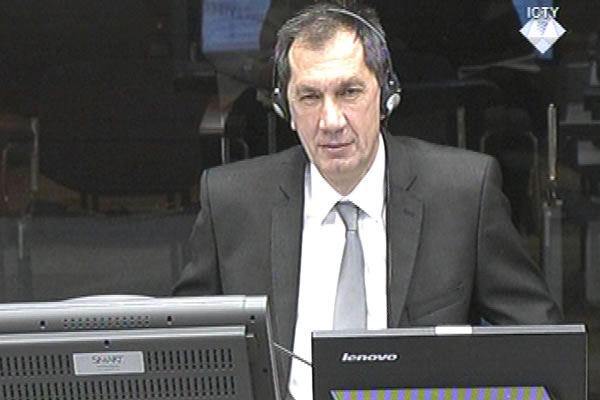Home
OBSTRUCTING ‘NON-EXISTENT’ TRIBUNAL IN THE HAGUE
Dragan Kijac continued his evidence in Ratko Mladic’s defense. Kijac, who headed the Bosnian Serb secret police during the war and later became the police minister, had claimed that he didn’t know anything about the Srebrenica crimes until 2000. The prosecutor contested Kijac’s claims with the evidence showing that Kijac was involved in an operation in which false documents were issued to the killers from the 10th Commando Detachment. The unit members were given false papers to protect them from the Tribunal in The Hague, the prosecutor emphasized. The witness replied that at the time the Tribunal ‘did not exist’ as far as he was concerned. Kijac noted that there was no law in Republika Srpska regulating cooperation with the Tribunal
 Dragan Kijac, defence witness at Rako Mladic trial
Dragan Kijac, defence witness at Rako Mladic trial Before his evidence was interrupted on 21 October 2015, Dragan Kijac claimed that in July 1995 he didn’t know anything about the mass executions of Srebrenica boys and men. In 1996 there were some ‘rumors’ about the crime, Kijac said, adding that he only learned about the executions of Muslims in 2000. During the war, Kijac was the chief of the Republika Srpska MUP State Security Service. As Kijac’s cross-examination continued today, the prosecutor contested Kijac’s claims. According to the prosecutor’s evidence, as early as in mid-January 1996, Kijac knew about the scale of the Srebrenica crimes. At that time, he was already the police minister.
In mid-January 1996, Kijac received a cable signed by Petar Salapura from the intelligence and security department of the Bosnian Serb Army Main Staff. The police was asked to issue false IDs to eight members of the VRS 10th Commando Detachment. The unit members were under investigation of the Tribunal in The Hague for their involvement in the executions of captured Muslims. When the prosecutor put it to Kijac that it was an attempt to hide the perpetrators from the justice, Kijac replied that at the time the Tribunal ‘did not exist’ as far as he was concerned because there was no law in Republika Srpska regulating cooperation with the ICTY.
Presiding judge Orie remarked that it was a ‘small-scale secret operation’ to obstruct the work of the Tribunal in The Hague. ‘From this point of view, yes, it was’, Kijac responded. The witness nevertheless explained that it was his duty to comply with the orders he received from the military secret service. In fact, as he explained, he didn’t know the real names of the persons he provided with false personal documents.
Drazen Erdemovic was one of the unit members. In an interview he gave to the Paris daily Le Figaro, which was later published in Slobodna Bosna on 22 March 1996, Erdemovic described how the prisoners were executed in Branjevo and Pilica. In the interview Erdemovic admitted that about 1,200 captives were killed in that operation. He personally had to kill about 70 or 100 prisoners, Erdemovic told the journalist. Kijac dismissed the prosecutor’s suggestion that as the police minister he had to have known about the interview.
The witness claimed he wasn’t aware of a statement made by Madeleine Albright, US State Secretary, at a press conference in Sarajevo on 21 March 1996. Albright spoke about her visit to Branjevo and the evidence that 1,000 Srebrenica inhabitants had been executed. A report broadcast by the BH TV network was played in court. The witness replied that he had not been following the TV channel from Sarajevo. He would have to see what the Serbian TV station (SRT) and the Serbian News Agency (SRNA) had aired. In his war diary, Ratko Mladic quoted Radovan Karadzic’s words at a meeting on 22 March 1996. Karadzic said that ‘a great show was put on for Albright’ the day before, on 21 March 1996. The US State Secretary expected to see ‘1,200 Muslim bodies in Pilica but she only saw about five victims’.
In the re-examination, defense counsel Lukic presented a series of police documents issued after the fall of Srebrenica. The documents describe the attempt of the Muslims from Srebrenica to break through towards Tuzla. Kijac used the opportunity to say that the MUP and his State Security were primarily interested in learning about the movement of the column. They didn’t care about the fate of the captured Muslims, Kijac said. One of the documents presented today was drafted much later, on 23 September 1996. The document states that during the ‘break-through of the Muslim forces’ from Srebrenica last year ‘there were several incidents in which Muslims were killed individually or en masse. The killings were organized by their officers in order to create chaos in the rear of the column which would divert the attention of the VRS from the front of the column, making it easier for them to escape. According to Kijac, ‘the officers of the military and civilian municipal authorities’ were at the front of the column. Kijac remembered the document and confirmed that the account tallied with what he knew about the situation.
As the hearing drew to a close, the defense called another expert witness, Mitar Kovac, a retired Serbian military general.
Linked Reports
- Case : Mladic
- 2015-11-11 KRAJINA WAS MLADIC’S TESTING GROUND FOR BOSNIA
- 2015-11-10 ‘THE LESS I KNOW, THE BETTER I AM’
- 2015-11-09 ARMY'S ROLE IN OMARSKA AND TOMASICA
- 2015-11-16 ‘TYPICAL CIVIL WAR’ IN BH
- 2015-11-17 EXPLOITING ISLAMOPHOBIA IN TRIBUNAL’S COURTROOM
- 2015-11-18 ‘PLAGIARISM’ IN MLADIC’S EXPERT REPORT
